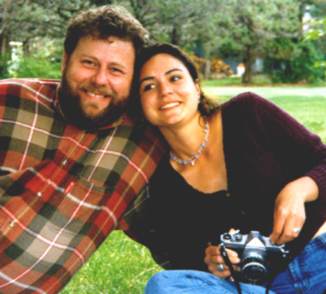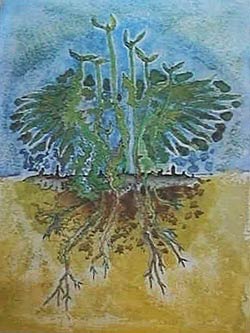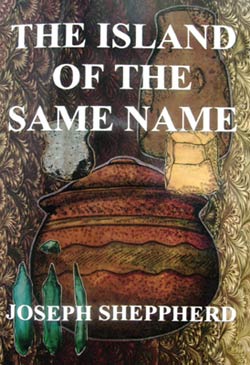BAFA © 2010. All material here is copyrighted. See conditions above. |
Joseph Sheppherd
author, anthropologist, archaeologist, U.S.A.
|

Joseph Sheppherd with his daughter, Anisa,
who was the inspiration for the character, Maya in his novel, Island of the Same Name.
|
Alison Marshall in New Zealand of Arts Dialogue interviews Joseph Sheppherd in Oregon via the
Internet concerning his latest book
The Island of the Same Name.
AM: Tell me about yourself and your interest in anthropology and archaeology.
JS: First and foremost, I am a Bahá´í. For more than three decades the
teachings of Baha’u’lláh
have influenced everything I have done. The spiritual path I began to tread when I was a teenager h
as lead me to be interested in the present and past conditions of human beings.
AM: What lead you to start writing fiction?
|
 JS: While reading children’s books to my daughter Anisa, I found that most of the stories
portrayed boys as subtly superior over girls. I decided to write something less sexist for her,
something with SHEros as well as HEros. The result was the Goli and Kadjam adventures.
JS: While reading children’s books to my daughter Anisa, I found that most of the stories
portrayed boys as subtly superior over girls. I decided to write something less sexist for her,
something with SHEros as well as HEros. The result was the Goli and Kadjam adventures.
Later, when I began to write with adults in mind, I drew from my own experiences carrying out academic fieldwork.
I discovered that to be successful in writing academic non-fiction, the trick is not requiring
readers to believe something impossible for them to believe. I learned this the hard way. I
showed an early version of A Leaf of Honey to a professor of mine at Cambridge University only
to be told that the research was more suitable for Reader’s Digest than a serious publisher. After
that, I edited out all of the unbelievable, but true, events and discoveries, and made it
palatable to academics. It is now used as an anthropological textbook. However, I saved the parts
I took out and used them in novels. In doing this, I learned an interesting fact of human nature.
If you present unbelievable facts to readers in the form of non-fiction, they will say: ´Neh,
life isn’t like that". But if you present the same facts in the name of fiction, readers are apt
to sigh and say: "If only life were like that".
AM: Tell me about the books you have written.
JS: In no particular order they are:
-
A Leaf of Honey and the Proverbs of the Rainforest,
a cultural anthropological study of the Ntumu tribesmen of Cameroon;
-
Close But Not Collide, a collection of poetry;
-
Extinct and Extant Peoples of the Americas, a hemispherical study of the
process of cultural extinction and survival;
-
Guebe and the Toy Truck, children’s fiction which deals with sexist attitudes among children;
-
Mama Buzurg is Coming; another children’s book about children’s fears;
-
My Grandma Was a Lamb When She Was Little, a collection of family stories and genealogy;
-
Ntumu Phonology, a preliminary study in Bantu-related linguistics;
-
Prehistoric Production and Dispersal of Groundstone Artifacts of the Island of Bioko,
the national archaeological survey of Equatorial Guinea;
-
The Elements of the Bahá´í Faith, an introductory book; and finally
-
The Island of the Same Name, an epic story in the genre of historical and speculative fiction.
 AM: How does your anthropology and archaeology affect your writing? AM: How does your anthropology and archaeology affect your writing?
JS: My anthropological fieldwork has allowed me to meet remarkable people including shamans,
sages and seers. These are lives about which I write. My archaeology has introduced me to the
humbling reality of things long dead and almost forgotten. It has also reminded me of the brevity of
physical existence in general and my life in particular. Like the things I dig up, the physical
product of my life may very well be the object of some future archaeologist. It is little wonder,
therefore, that archaeology and archaeologists figure in my writings, as backdrops and protagonists.
I believe that archaeologists, like historians are the prophets of hindsight. It is strange that
when they write, their work is considered as non-fiction. Archaeologists are not unlike seers.
The PRE-history that they characterize is comparable in its equivocal nature to the POST-history
which seers predict. They both function within a universe which provides them with only glimpses
of the traces of things where nothing is truly perceived definitively. When they write or speak,
there is no absolute reality to describe: the manifest and the hidden abide within each other,
the seen hints of the existence of the unseen and the known whispers of the unknown. The words
of both the archaeologist and the seer reflect this.
This is, perhaps, why our vision of both the
past and future share the same sense of mystery. The people who claim to apprehend conditions
outside of their own time, can really only recount their fleeting glimpses of the traces of things
which are ultimately unknowable to others. They can never really prove anything about the past or
the future, no one can. Even with the passage of time, the accuracy of what they have said will be
examined by others with the same limited vision, and the product of their momentary insight will be
categorized as either fact or fiction. This, however, is of secondary importance to the archaeologist
and seer. In the present, what really matters is if they are believed or not...
AM: Can you give a run down on what happens in The Island of the Same Name?
JS: This novel follows the adventures and discoveries of two generations of researchers: an archaeologist
named Hemet Recuero Holden and his daughter Maya Lillian Holden, an anthropologist. Each in turn, visits
the same African island, but each discovers vastly different things...
Excerpts from Arts Dialogue, September 1999, pages 14 - 15
|
Contact: Manifest Books, P.O. Box 9279, Bend, Oregon, 97708, U.S.A.
|
- Interview : Arts Dialogue, September 1999
- An excerpt from his novel : Island of the Same Name, Arts Dialogue, June 1999
|

Arts Dialogue, Dintel 20, NL 7333 MC, Apeldoorn, The Netherlands
email: bafa@bahai-library.com
|
|

 JS: While reading children’s books to my daughter Anisa, I found that most of the stories
portrayed boys as subtly superior over girls. I decided to write something less sexist for her,
something with SHEros as well as HEros. The result was the Goli and Kadjam adventures.
JS: While reading children’s books to my daughter Anisa, I found that most of the stories
portrayed boys as subtly superior over girls. I decided to write something less sexist for her,
something with SHEros as well as HEros. The result was the Goli and Kadjam adventures.  AM: How does your anthropology and archaeology affect your writing?
AM: How does your anthropology and archaeology affect your writing?